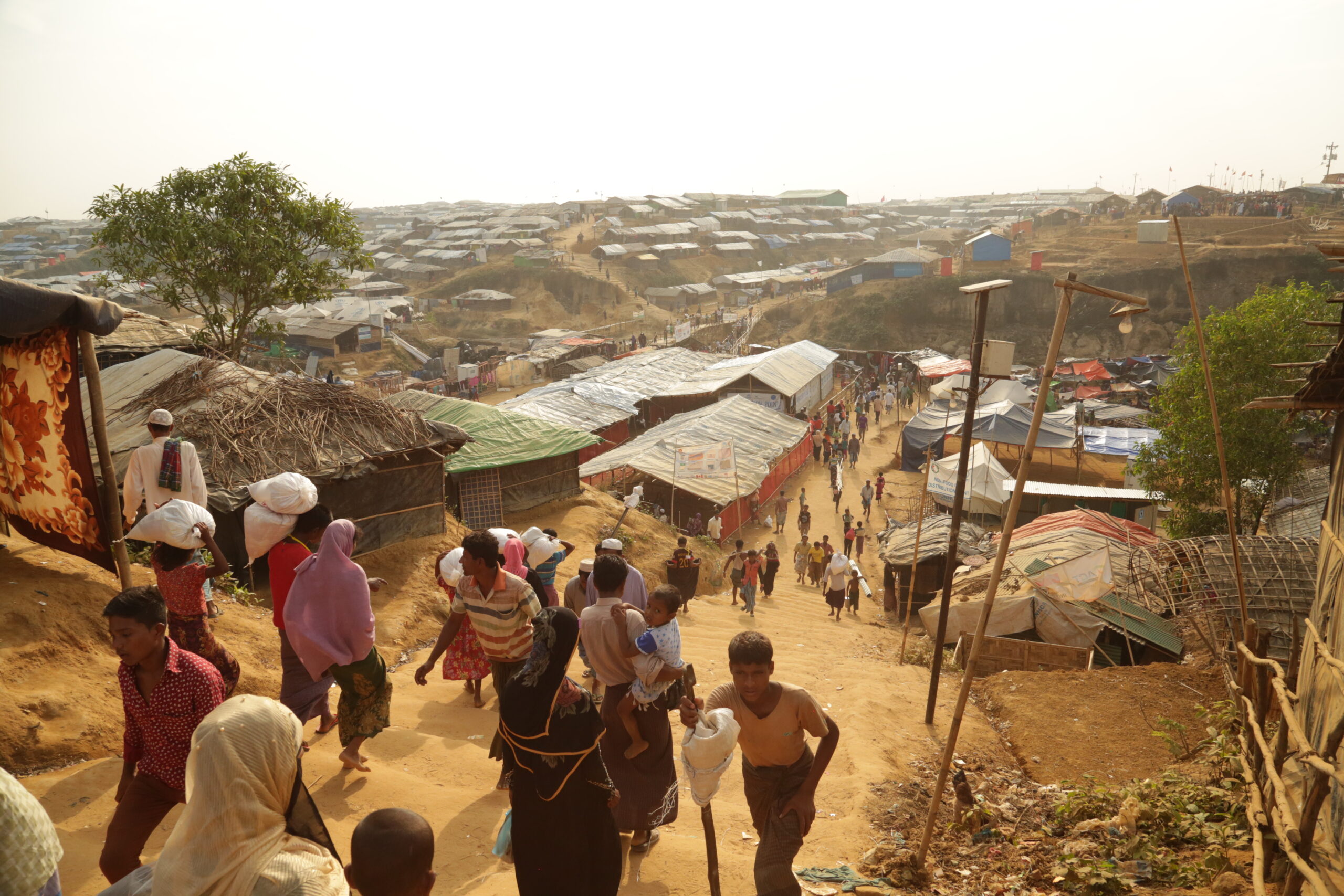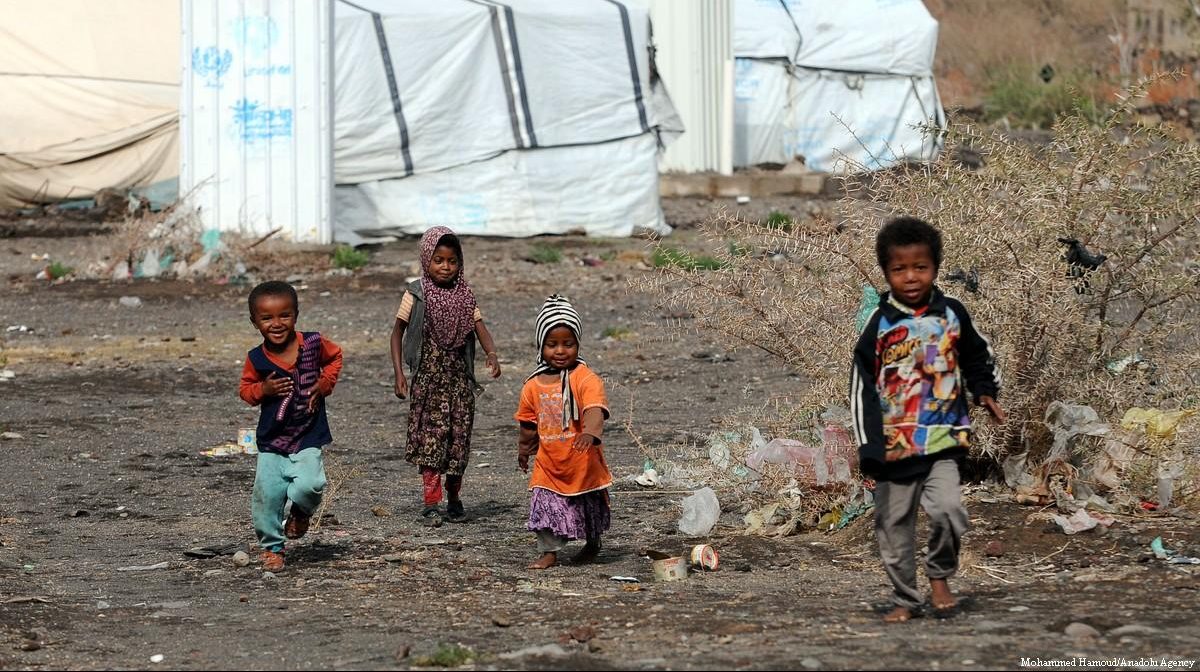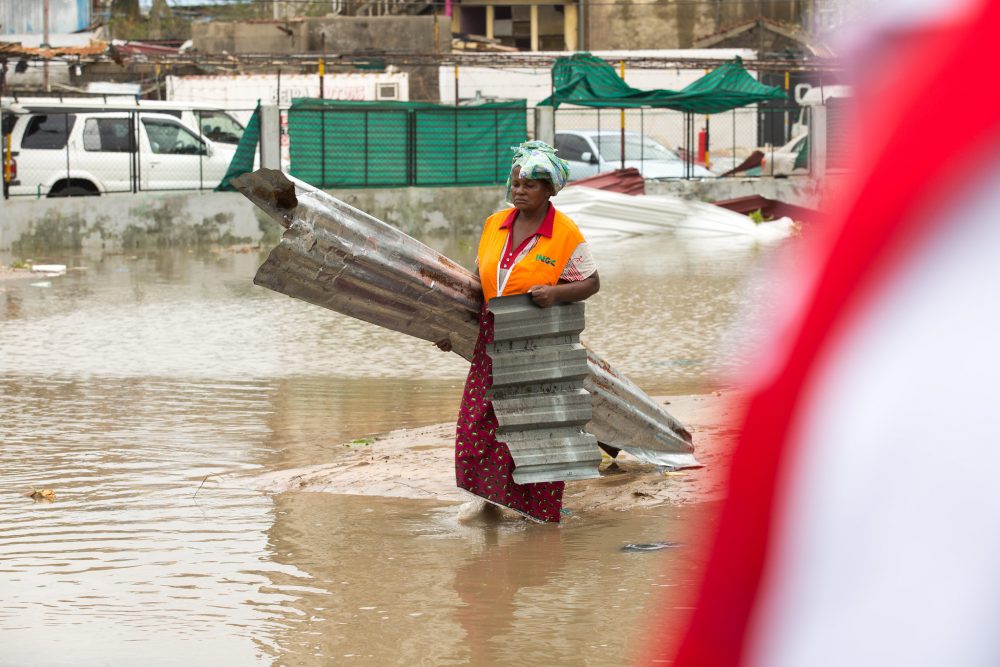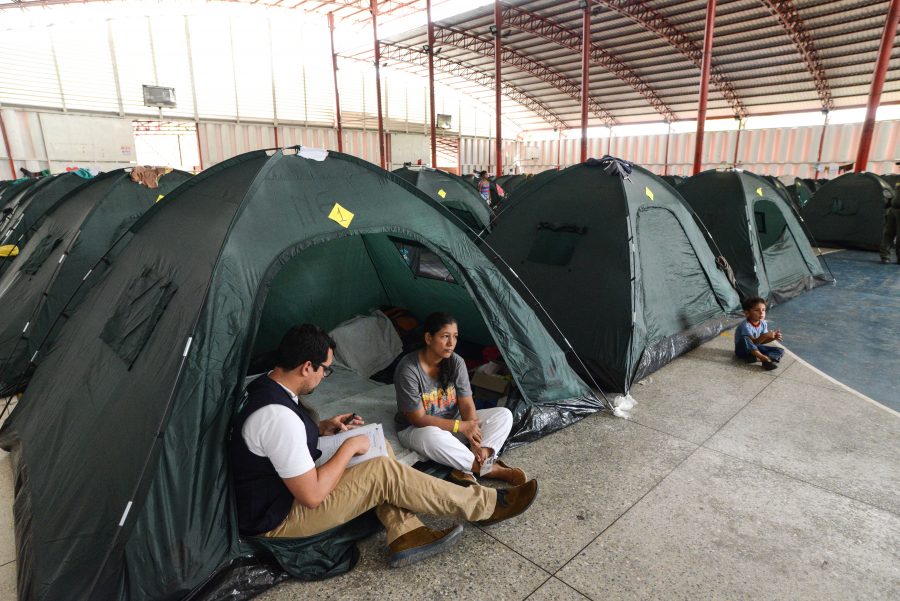 Video
Video
 Video
Video
The Rohingya people are a stateless Muslim minority in the western Myanmar state of Rakhine. They have been forced out of Myanmar (also known as Burma) by violence and racism for more than 20 years.
Myanmar’s government refuses to recognize the Rohingya people as one of the 135 official minority groups in the country, denying them citizenship as long as they identify as Rohingya. The most recent crisis began in August 2017 when hundreds of thousands of Rohingya people — more than half of whom were children —fled violence against them by seeking refuge in neighboring Bangladesh.
Currently, the United Nations High Commissioner for Refugees (UNHCR), the UN Refugee Agency, estimates that, as of Dec. 31, 2021, there are 918,841 individuals (192,908 families) residing in camps in Bangladesh. The average family is 4.7 people. All but 4% arrived after 2016. Most of these refugees have settled in the Cox’s Bazar region of Bangladesh, living in sprawling refugee camps, either UNHCR managed or unofficial settlements. Of the refugees in the camps, 52% are children, 4% are older persons and 1% are people with a disability. There are slightly more women than men at 52% to 48%. Of the Rohingya, 68% came from Maungdaw township.
(Photo: View of the sprawling Kutupalong refugee camp near Cox’s Bazar, Bangladesh. Source: Russell Watkins/Department for International Development; CC BY 2.0)
The Bangladeshi government is trying to get refugees to move to a remote island in the Bay of Bengal. Bangladesh developed the island specifically for the purpose of helping to resettle Rohingya refugees and move them out of temporary refugee camps in the Cox’s Bazar region. By the end of 2021, almost 17,000 Rohingya had been moved to the island of Bhasan Char – a drop of over 2,000 from the end of September 2021. Although they have been promised safe and secure shelter, along with access to other supports including food and health services, aid workers say the island is in the path of cyclones. Despite an improvement in living conditions, the Rohingya on Bhasan Char say they are prisoners, unable to leave the island without permission from the government of Bangladesh. This may change as, on Oct. 11, 2021, the government and the United Nations signed a memorandum to facilitate aid and support to residents on the island. By the end of February 2022, an additional 81,000 refugees are going to be relocated to the island.
What is life like for people in the temporary camps?
The conditions in the camp are not always the safest, despite the large presence of humanitarian aid organizations on the ground. In the first two weeks of 2022, there were two large fires, one that burned quickly through a COVID-19 treatment center run by the International Organization for Migration (IOM) on Jan. 2, and a second one that burned through what is known as Camp 16 on Jan. 9. While there were only minor injuries in the Camp 16 fire and no deaths reported in either fire, they demonstrate the challenges of living and caring for people in an area where “the only temporary shelters that are allowed in the camps in Bangladesh are those made of highly flammable bamboo and tarpaulin.” The fire on Jan. 9 reportedly destroyed 600 shelters and left 3,600 Rohingya refugees homeless.
There were also a series of fires in the camps in 2021, leading to fears that the government is trying to push residents to leave. A fire on Jan. 14, 2021 gutted the Nayapara refugee camp in Cox’s Bazar, destroying 550 shelters and 150 shops and leaving approximately 3,500 people homeless. On March 22, 2021, a large fire swept through the Balukhali camp before spreading to two other camps, consuming 500 acres and destroying 10,000 encampments. At least 45,000 people became homeless, along with nearly 600 injured and 15 killed. Aid workers and refugees alike blamed barbed wire in the camps for preventing people from fleeing quickly. A briefing note from March 2021, shows how the March fires impacted the camps and the refugees within them. A fire on April 2 killed three people and destroyed about 20 shops in a makeshift market near Kutapalong.
What are some of the ongoing concerns for the Rohingya?
Massive flooding from heavy monsoon rains at the end of July 2021 led to landslides and the deaths of at least 14 people (including local villagers and Rohingya). At least 13,000 Rohingya refugees have been affected with more than 10,000 being moved to safer locations. The UN reports that at least 2,500 shelters were damaged or destroyed.
The temporary settlements in Cox’s Bazar were put up very quickly, leading to concerns about WASH (Water, Sanitation and Hygiene), shelter, and safety for women and girls. The limited WASH facilities have also contributed to concerns about COVID-19 spreading within the settlements. The tight spaces, accompanied by the lack of access to basic services, especially healthcare, leave those residing in Cox’s Bazar especially vulnerable to the virus. As a result of these concerns, Bangladesh imposed a complete lockdown on Cox’s Bazar with only critical aid and healthcare staff being allowed to enter and exit the area, which was only lifted in August 2021.
The first case of COVID-19 in Cox’s Bazar was confirmed on May 15, 2020, with the first death confirmed on May 30, 2020. As of Sept. 19, 2021, the World Health Organization (WHO) reported that there have been 3,026 confirmed cases and 32 deaths in the camps. While there are some concentrations of cases, no camp holds a majority and deaths are spread throughout the camps. One-third of these cases occurred in July and August alone (over 1,000 cases and 10 deaths).
On Aug. 10, 2021, a massive vaccination campaign began with more than 4,000 refugees getting vaccinated in the first few days. In total, 36,900 refugees were vaccinated: 86% of the target goal. The WHO had previously reported that the vaccination campaign would be aimed at Rohingya refugees over 55 years, starting with community leaders over 55 years, followed by all persons over 55 years in the Rohingya camps. The second round of vaccinations started Sept. 18, 2021.
In addition to the toll COVID-19 is taking on the physical health of Rohingya refugees, the increased restrictions on aid and aid workers have also reduced the amount of mental health support available to these displaced people. Bangladesh has nearly 1.6 million COVID-19 cases and just over 28,000 deaths. Despite the challenges of living and working in temporary encampments, aid organizations are finding ways to enable Rohingya refugees to be self-sufficient. The first small-scale harvest of locally-grown mushrooms was accomplished at the end of 2021, and the World Food Programme (WFP) along with the Food and Agricultural Organization of the United Nations (FAO) helped provide almost 6,000 refugees with the necessary inputs to start their own local agricultural production.
What opportunities exist for resolution of this crisis?
Hopes for the repatriation of the Rohingya to their traditional lands rose with the re-election of the National League for Democracy (NLD) during November 2020 elections. Many countries and organizations around the world pushed Myanmar’s state counselor and leader of the NLD, Aung Suu Kyi, to repatriate the Rohingya in circumstances that will allow them to thrive. However, on Feb.1, 2021, there was a military coup d’état and both Suu Kyi and President Win Myint, along with other NLD leaders, were detained by the Tatmawdaw (the official name of the armed forces). Leaders around the world strongly condemned the coup and warned of tougher sanctions and fears of outright civil war. At least 10,000 refugees have fled Myanmar since the coup, although not all ended up in Bangladesh. Several human rights officials have asked President Biden to condemn the Tatmawdaw for their previous actions and hold them accountable for genocide. Suu Kyi has been convicted twice since her arrest and sentenced (so far) to six years in jail, with additional charges pending against her.
A new parallel government has been formed that includes some members of the NLD. The National Unity Group (NUG) recently announced broad changes in an effort to bring the Rohingya on to their side. In a statement, the NUG said they, “would scrap a 1982 citizenship law that denies Rohingya citizenship, and which has effectively rendered them one of the largest stateless populations in the world. Citizenship would instead be based on birth in Myanmar, or birth anywhere to a Myanmar citizen … The NUG, which was set up after the military coup, also said it was committed to the safe repatriation of Rohingya who have been forced to flee military violence, and promised to ‘actively seek justice and accountability for all crimes committed by the military against the Rohingya’.”
Whether in Cox’s Bazar or on the island of Bhasan Char, the needs of the displaced Rohingya people are complex.
Sexual and gender-based violence prevention and response
The United Nations (UN) says, “Assessments indicate that adolescent Rohingya girls’ risk of gender-based violence (GBV) has increased since the onset of the COVID-19 pandemic. In response, UNHCR will newly implement ‘Girl Shine’ in 2021 through its partners BRAC and Relief International. As a first step to implementing the new programme, a training-of-trainers took place where 21 participants learned about the programme’s tools and core concepts. These staff members will facilitate the programme for the first cohort of girls in the camps after tool adaptation is complete. The programme model, originated by the International Rescue Committee, works with adolescent girls and their caregivers, building the girls’ life skills, social networks, and knowledge about GBV, enabling them to better protect themselves and their peers.”
Water, sanitation and hygiene (WASH) facilities
While a large number of handwashing taps were installed in households, COVID-19 delayed plans of many organizations to install sanitation facilities. From the beginning of the COVID-19 pandemic to the end of May 2021, almost 120,000 handwashing “tippy taps” (a handwashing device that is cost-effective and hands-free) have been installed. The majority of households continue to receive bath and laundry soap, as well as menstrual hygiene kits. Facilities are regularly being disinfected with chlorine solution.
Testing capacity for COVID-19
Given the high rates of COVID-19 positivity tests, it is important that there be widespread testing to help with contact tracing. However, only 200-300 tests are available daily.
Unrestricted financial support to responding agencies
In addition to the UN, there are at least 27 operational nongovernmental organizations (NGOs the UNHCR refers to as partners) working to support UNHCR during this complex humanitarian emergency. With much of the philanthropic support and attention of the world focused on COVID-19, support for ongoing humanitarian emergencies is key.
Support for camp and building design and construction
The vast majority of these structures were built without planning or preparation to ensure their long-term viability. As a result, they are susceptible to flooding and unstable slopes, particularly during the monsoon season. UNHCR is working with other agencies to ensure the long-term stability of these structures as there is no end in sight to this complex humanitarian emergency. This includes providing rope and wire to be used as tie-down kits. Not all the shelters destroyed in the fires have been rebuilt yet.
Mental health and counseling support
The traumas that occurred in Myanmar and led people to flee will require ongoing support and counseling to address. However, there are additional traumas and issues developed within camps that also require support, including the impacts of COVID-19 and the effects of the lockdown, the recent string of fires, and the losses incurred in the spring and summer floods.

The Center for Disaster Philanthropy (CDP) has a Global Recovery Fund that provides an opportunity for donors to meet the ongoing and ever-expanding challenges presented by global crises.
Contact CDP
Philanthropic contributions
If you would like to make a donation to the CDP Global Recovery Fund, please contact development.
Recovery updates
If you are a responding NGO or a donor, please send updates on how you are working on recovery from this disaster to Tanya Gulliver-Garcia.
More ways to help
The United States announced additional funding to support the Rohingya refugees on Sept. 22, 2021. In a press release it stated, “On behalf of the United States, Ambassador to the United Nations Linda Thomas-Greenfield announced nearly $180 million in additional humanitarian assistance for those affected by the Rakhine State/Rohingya refugee crisis in Burma, Bangladesh, and elsewhere in the region. With this new funding, our total humanitarian assistance for this response reaches more than $1.5 billion since August 2017, when more than 740,000 Rohingya were forced to flee ethnic cleansing and other horrific atrocities and abuses in Burma’s Rakhine State to safety in Cox’s Bazar, Bangladesh. This total funding has included more than $1.2 billion for programs in Bangladesh and allows our humanitarian partners to provide life-saving assistance to the nearly 900,000 Rohingya refugees in Bangladesh. It also provides support to more than 472,000 affected members of the local host community in Bangladesh.”
Resources

Refugees
Refugees are people who have been forced to flee their home countries because of persecution, war or violence. A refugee has a well-founded fear of persecution for reasons of race, religion, nationality, political opinion or membership in a particular social group. Many refugees are in exile to escape the effects of natural or human-made disasters.

Women and Girls in Disasters
Pre-existing, structural gender inequalities mean that disasters affect women and girls in different ways than they affect boys and men. The vulnerability of females increases when they are in a lower socioeconomic group.

Complex Humanitarian Emergencies
CHEs involve an acute emergency layered over ongoing instability. Multiple scenarios can cause CHEs, like the civil wars in Syria and Yemen, the man-made political crisis in Venezuela, or the conflict in Ukraine.